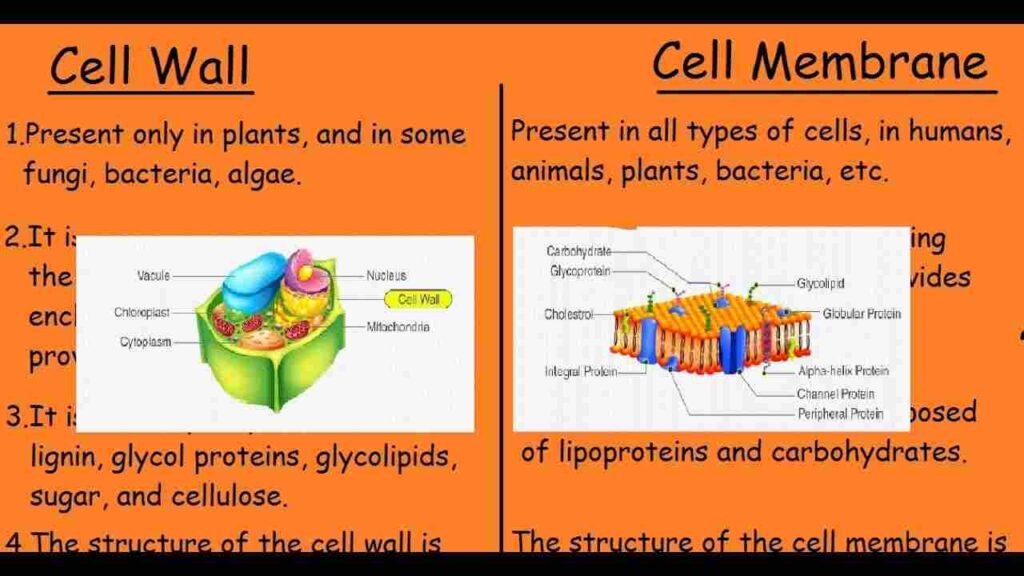
Explore 15 Key Difference between Plasma membrane and Cell wall
Plasma membrane and cell wall are two important components found in cells, but they have distinct differences in their structure and function. Here are 15 key difference between the plasma membrane and the cell wall explained in simple words for your upcoming exams.
Difference between Plasma membrane and Cell wall
Composition: The plasma membrane is primarily composed of lipids, such as phospholipids, while the cell wall is made up of carbohydrates, such as cellulose, and may contain other substances like proteins and lignin.
Location: The plasma membrane is a thin layer that surrounds the cell, separating its internal components from the external environment. In contrast, the cell wall is an additional rigid layer found outside the plasma membrane, providing structural support and protection.
Permeability: The plasma membrane is selectively permeable, allowing certain molecules to pass through while restricting others. In contrast, the cell wall is porous and allows the passage of water, ions, and other molecules freely.
Function: The plasma membrane regulates the movement of substances in and out of the cell, maintains cell shape, and participates in cell signaling. The cell wall provides structural support, protects the cell from mechanical stress, and helps maintain the shape of the cell.
Flexibility: The plasma membrane is fluid and flexible, allowing the cell to change shape. On the other hand, the cell wall is rigid and provides a fixed shape and structure to the cell.
Presence in cell types: The plasma membrane is present in all types of cells, including animal cells and plant cells. The cell wall is found in plant cells, fungi, bacteria, and some protists but not in animal cells.
Thickness: The plasma membrane is thin, typically about 5-10 nanometers in thickness. In contrast, the cell wall is thicker, ranging from 10-100 times the thickness of the plasma membrane.
Growth: The plasma membrane does not grow, but the cell wall can expand and accommodate cell growth by adding new layers.
Cell-cell interaction: The plasma membrane allows direct cell-cell interactions, enabling communication and coordination between neighboring cells. The cell wall, being rigid, limits direct interaction between cells but provides mechanical support to the entire tissue.
Sensitivity to osmotic pressure: The plasma membrane is sensitive to changes in osmotic pressure and can regulate the movement of water to maintain cell volume. The cell wall provides rigidity and prevents the cell from bursting or collapsing due to osmotic pressure changes.
Formation during cell division: The plasma membrane is formed by the fusion of vesicles and endoplasmic reticulum during cell division. The cell wall is built by the secretion of new materials by the Golgi apparatus and other cell structures.
Repair and regeneration: The plasma membrane has the ability to repair itself when damaged. In contrast, the cell wall cannot repair itself, and if damaged, the cell may die.
Variability: The composition and structure of the plasma membrane can vary depending on cell type and function. The cell wall composition is more uniform within a given species or cell type.
Presence of transport proteins: The plasma membrane contains various transport proteins that help in the movement of molecules across the membrane. The cell wall does not contain transport proteins.
Protection against pathogens: The plasma membrane can participate in immune responses and defense mechanisms against pathogens. The cell wall provides a physical barrier and offers protection against certain pathogens.
The plasma membrane and cell wall have different compositions, functions, permeability, flexibility, and roles in cell growth and protection. Understanding these differences is crucial for comprehending the diversity and complexity of cellular structures and functions in various organisms.
Also Read: Explore 15 Key Difference between Multiplexer and Demultiplexer